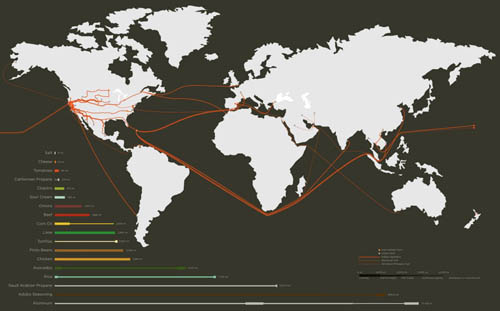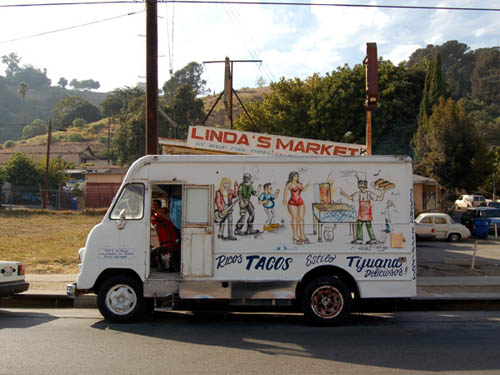Where does your taco come from?
 Like a culinary version of Sourcemap, Rebar has teamed up with landscape architect David Fletcher and some students from the increasingly interesting California College of the Arts in San Francisco to explore the ingredients of your local taco—from pinto beans to the aluminum foil it all comes wrapped in.
Like a culinary version of Sourcemap, Rebar has teamed up with landscape architect David Fletcher and some students from the increasingly interesting California College of the Arts in San Francisco to explore the ingredients of your local taco—from pinto beans to the aluminum foil it all comes wrapped in.- Our premise was that a seemingly simple, familiar food like the taco truck taco could provide visceral insight into the connections between the systems we were exploring [in our studio's investigation of the city]. By thoroughly learning the process of formation and lifecycle for what it takes to make a taco, we would be better able to propose and design a speculative model of a holistic and sustainable urban future. What resulted was a richly complex network of systems, flows and ecologies that we call the global Tacoshed.
The Studio for Urban Projects, meanwhile, has a pretty fascinating list of previous endeavors, including Foodshed, Strange Weather, and the awesome Unnatural History of Golden Gate Park. Large parts of what are now west San Francisco were once covered by nomadic sand dunes, a kind of peninsular erg; that granular presence is now only temporarily locked in place beneath the foundations of houses. Every grain you see blowing down a San Franciscan street is this lost geography attempting to reassert itself.
Beneath your feet, San Francisco, something ancient is patiently waiting.
 [Image: "There are two basic types of taco trucks," we read; "the first and most common is the transient truck which is a truck that stops at approximately 20 different locations at 20-minute intervals during an 8-hour shift, typically beginning at 6am and ending at 2pm. The second type is the semi-permanent truck, which is a truck that has found a location that has a density of clientele to sustain it for an extended period of the day, creating a nearly fixed presence in a particular community." From Polar Inertia].
[Image: "There are two basic types of taco trucks," we read; "the first and most common is the transient truck which is a truck that stops at approximately 20 different locations at 20-minute intervals during an 8-hour shift, typically beginning at 6am and ending at 2pm. The second type is the semi-permanent truck, which is a truck that has found a location that has a density of clientele to sustain it for an extended period of the day, creating a nearly fixed presence in a particular community." From Polar Inertia].And I can't let this post end without calling attention to the excellent—in fact, extraordinary—Polar Inertia, specifically its photo-essay published more than four years ago tracing the taco-truck geography of greater Los Angeles. These dispersed infrastructures might now be quite trendy, but the functional networks things like taco trucks actually form on the streets of our cities are still worth mapping in full.
(On an unrelated note, my older brother apparently wanted to name me "Taco"—not Geoff—but my parents, luckily, got to decide).





Comments are moderated.
If it's not spam, it will appear here shortly!
A few places come to mind... I have eaten tacos from all over the world, including Mexico, where, I must say, they are quite good... However, here in the good old USA, I personally think the best tacos reside. If you ever get a chance, go to Casa Que Pasa in Bellingham, Washington, for great tacos (I like the carnitas) and wonderful Potato Burritos (wow, these are good). If you ever find yourself in Portland, Oregon, I would suggest cruising on over to ?Por Que No? and try their awesome tacos and their Bryan's Bowl... This is some good grub!!! ~NSVM
maybe I'm dense but is there any link to the full-resolution tacoshed map?
Informational graphics are pointless when they're too small to read or comprehend. Even going to the Tacoshed site and zooming in on their graphic the only conclusion that I have is that our salt comes from 3 of the Great Lakes.
Hi guys,
Sorry for the misunderstanding! We released this info as a promotion for the event we're doing on 2/25 at the Studio for Urban Projects, not as a final presentation of the data. We'd like it if people who want to know where their taco comes from attend the event and join the discussion!
Hi-res files are of course important for web viewing, but you'll have to stay tuned for a post-event update on the Rebar blog.
Thanks for the feedback! We'll have a full-res map up soon.
Teresa Aguilera, Rebar
two questions:
(1) why oh why isn't the event happening on taco tuesday?
(2) will there be tacos at the event?
This is wonderful, it is a dream come true.I think there should be a World Atlas of and its space representation and not only tacos.
Marcia Zoladz, CCA alumni currently food writer and historian.
Post a Comment